
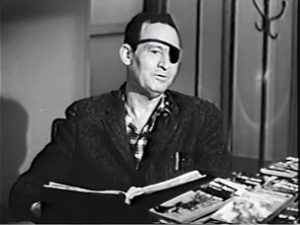 The New Adventures of Michael Shayne (1944-53) aired “The Case of the Man Who Lived Forever” on May 7, 1949. Since this is only the 2nd episode of this show we’ve run (the only other one was on July 2, 2022), it is time to reprise our original introduction for newcomers to this excellent detective program.
The New Adventures of Michael Shayne (1944-53) aired “The Case of the Man Who Lived Forever” on May 7, 1949. Since this is only the 2nd episode of this show we’ve run (the only other one was on July 2, 2022), it is time to reprise our original introduction for newcomers to this excellent detective program.
The show had three different iterations and titles: Michael Shayne, Private Detective (1944-47), The New Adventures of Michael Shayne (1948-49), and from 1952 until its demise in 1953 simply The Adventures of Michael Shayne. While each show had a different lead actor playing Shayne, many will say their favorite was probably film actor Jeff Chandler (1918-1961, photo below right), who played Shayne in The New Adventures of Michael Shayne, from which this week’s episode is taken.
(Pictured above is Mike Shayne Mystery Magazine from July 1977. The new Brett Halliday story featured on the cover was actually ghost-written by the magazine’s editor, Sam Merwin, Jr.)
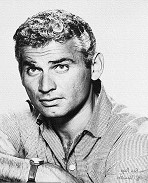 The character of Michael Shayne, Detective was the brainchild of Davis Dresser (1904-1977, photo top right) who used the pseudonym of Brett Halliday for his mystery novels. Rather prolific, he would also pen a number of westerns as well as many stories for other genre pulps using a variety of other pseudonyms, but it is the work bylined with the Brett Halliday pen name that has had the most enduring legacy of all of Dresser’s works. His first Michael Shayne novel, Dividend on Death (and first novel of any kind) was turned down by 21 publishers until Henry Holt & Co. bought and published it in 1939. Dresser would go on to write 30 Michael Shayne novels for the next 25 years or so, turning over the reins to others in 1958, leaving the series in the capable hands of the ghost writers. Some of these “ghost writers” (many quite popular in their own right as mystery novelists, or having proved themselves in other genres, including science fiction and/or fantasy) include Sam Merwin, Jr., Robert Arthur, Frank Belknap Long, and Bill Pronzini.
The character of Michael Shayne, Detective was the brainchild of Davis Dresser (1904-1977, photo top right) who used the pseudonym of Brett Halliday for his mystery novels. Rather prolific, he would also pen a number of westerns as well as many stories for other genre pulps using a variety of other pseudonyms, but it is the work bylined with the Brett Halliday pen name that has had the most enduring legacy of all of Dresser’s works. His first Michael Shayne novel, Dividend on Death (and first novel of any kind) was turned down by 21 publishers until Henry Holt & Co. bought and published it in 1939. Dresser would go on to write 30 Michael Shayne novels for the next 25 years or so, turning over the reins to others in 1958, leaving the series in the capable hands of the ghost writers. Some of these “ghost writers” (many quite popular in their own right as mystery novelists, or having proved themselves in other genres, including science fiction and/or fantasy) include Sam Merwin, Jr., Robert Arthur, Frank Belknap Long, and Bill Pronzini.
The Shayne character is of the hard-boiled detective school, and does not exhibit the highest ethical standards when it comes to catching the bad guys. Known as “the reckless, red-headed Irishman,” Shayne is no doubt derived from many of Dresser’s own life experiences. From his wikipedia page: “Dresser was born in Chicago, Illinois, but mostly grew up in West Texas. Here he lost an eye to barbed wire as a boy, and thus had to wear an eye patch for the rest of his life. At the age of 14, he ran away from home and enlisted in the U.S. 5th Cavalry Regiment at Fort Bliss, Texas, followed by a year of Border Patrol duty on the Rio Grande. After his service, he returned to Texas to finish high school. In search of adventure, Dresser traveled throughout the Southwest working at various odd jobs, including that of muleskinner, farm hand, deckhand on a freighter in the Gulf of Mexico, laborer in the California oilfields, etc. Eventually, he went to Tri-State College of Engineering, where he received a certificate in civil engineering. Back in Texas, he worked as an engineer and surveyor for several years before turning to writing in 1927.”
While Shayne’s given residence and base of operations in the novels was Miami, for the radio versions the script writers played a little fast and loose with his hometown and had him solving mysteries in Oakland and New Orleans before eventually returning to Miami. This story, for instance, has Shayne working out of New Orleans.
Dresser/Halliday was one of the founding members of the Mystery Writers of America and in 1954 he and his wife were honored with Edgar Awards for their critical work in the field. Dresser’s/Halliday’s Michael Shayne character was a multi-genre character, appearing not only in novels and on radio, but in films (7 films starring Lloyd Nolan, and 5 with Hugh Beaumont who would later star in TV’s Leave it to Beaver), a television show (1958-61), and even a comic book spinoff tie-in to the popular television show. And last but not least was the Michael Shayne Mystery Magazine, begun in 1956 and lasting for almost 30 years, which for several years was edited by Frank Belknap Long.
“The Case of the Man Who Lived Forever” has its roots in voodoo, that dark Caribbean religion exported to New Orleans and practiced under the radar (mostly) by many on a daily basis. Shayne is called to help a woman whose father is locked in his house in the dark and sits unmoving as if in a trance while waiting for his death. This strange request from a woman speaking with a pronounced Cajun/French patois and who admits she can’t pay Shayne very much, is the setting for this atmospheric adventure, one which turns out to be much more than an old man convinced he is about to die, and which naturally involves murder, but most of all it shows what the power of fear and superstition can hold over those who relinquish their will to powers they have been convinced are able to rule their lives, especially when they believe with every fiber in their being the story about the “Man Who Lived Forever.”
Play Time: 26:34
{The Michael Shayne episode about voodoo and death in New Orleans made for a good half hour of radio drama on a Saturday evening in early May of 1949. After church the next morning the neighborhood gang traded their Sunday best for jeans and t-shirts and met at the nearby newsstand for more dark and dangerous detective tales to recapture the mood they still rode high on from the night before. Street & Smith’s Detective Story (1915-53) was the first pulp magazine devoted to detective fiction. It continued in the footsteps of the recently defunct Nick Carter Stories publication by continuing a serial begun in that magazine. It published on an almost unbelievable weekly schedule for many years, then drew down to a more modest bi-weekly schedule from 1932–1935 and then continued as a monthly through most of 1948. It became a quarterly in 1949, but only managed 3 issues, the one shown below its next to last issue. An attempt to revive the long-running pulp was made in 1952 bit it managed but a single issue that year and only 5 in 1953 before folding for good. The Phantom Detective (1933-53) was one of the gang’s favorites, as it mixed the detective tale with an aura of mystery due to the pseudo-superhero-like Phantom Detective who reminded the gang of the Shadow. 1949 was the year its publishing schedule backed down a bit from a bi-monthly to a quarterly, the issue below being the first in its new quarterly run. Super-Detective (1934-50) was picked up occasionally over the years when the gang was caught up on their SF pulps, but it was on its last legs in June of 1949. It didn’t seem able to maintain any set schedule and managed but 4 scattershot issues that year. Though 1950 would make a valiant attempt at a comeback with 6 issues (5 as monthlies), it wouldn’t be enough to save the magazine and it folded with its October 1950 issue sans its Comic Section, a decision made a little too late to save the magazine.}
[Left: Detective Story, Spring/49 – Center: Phantom Detective, Spring/49 – Right: Super-Detective, 6/49]
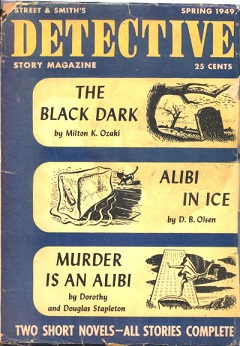
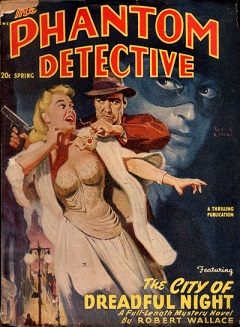
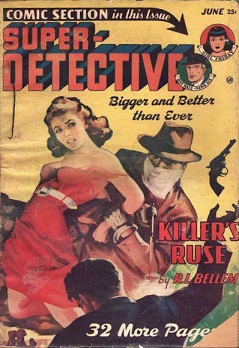
To view the entire list of weekly Old Time Radio episodes at Tangent Online, click here.